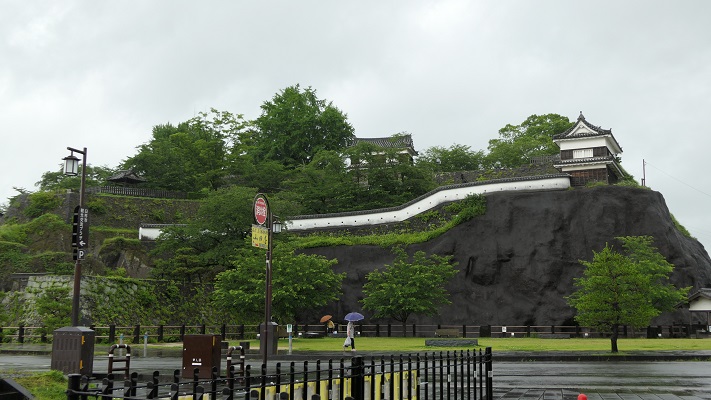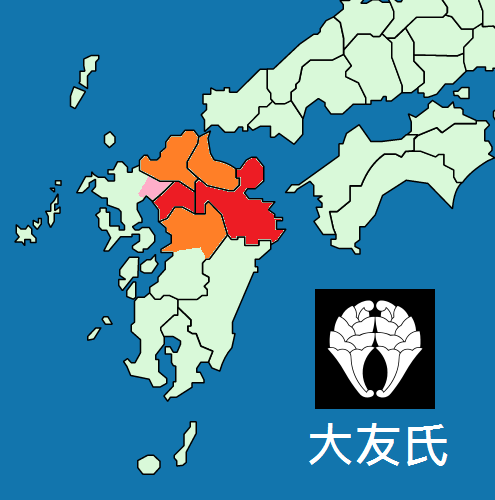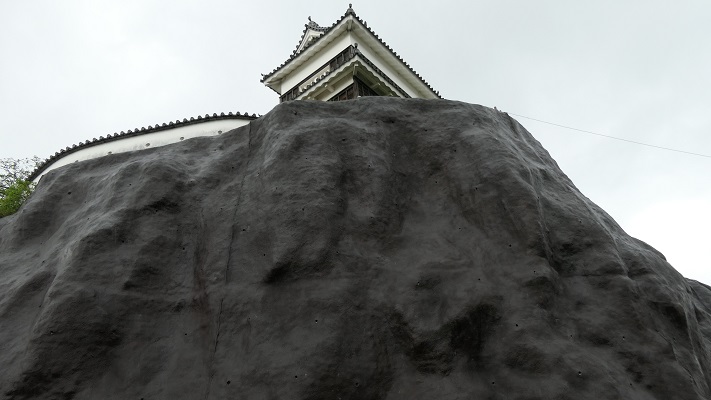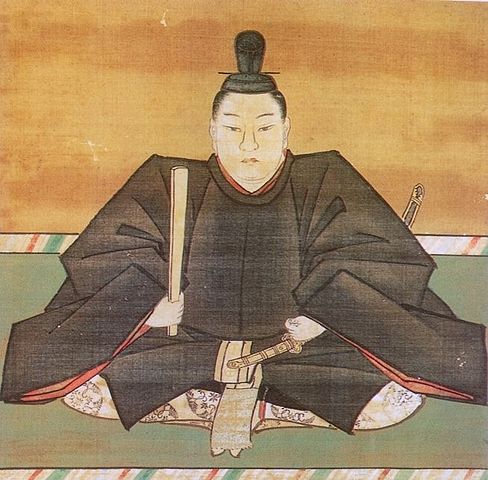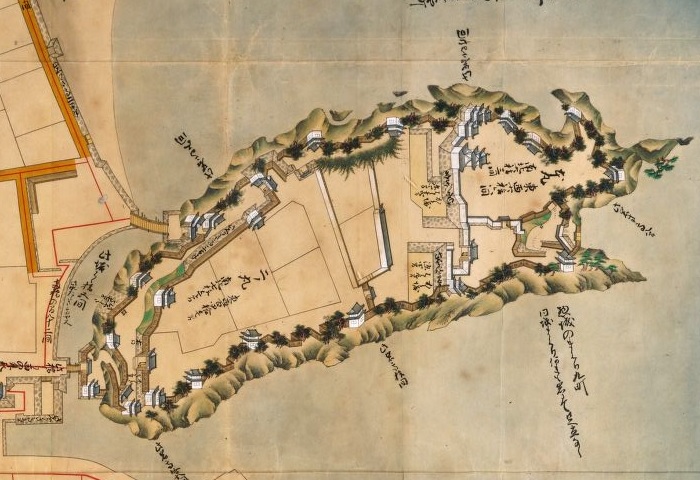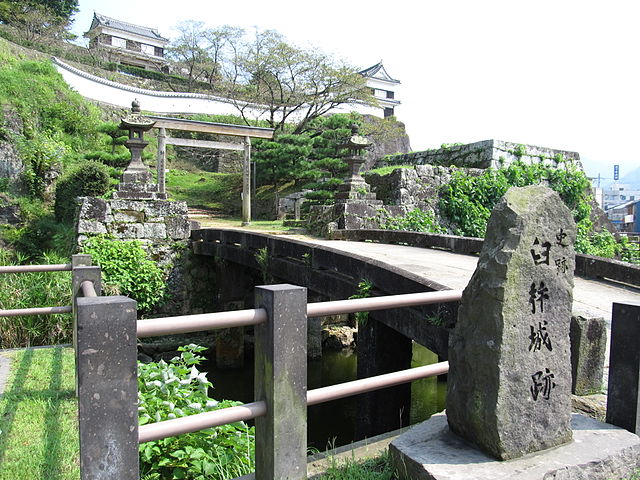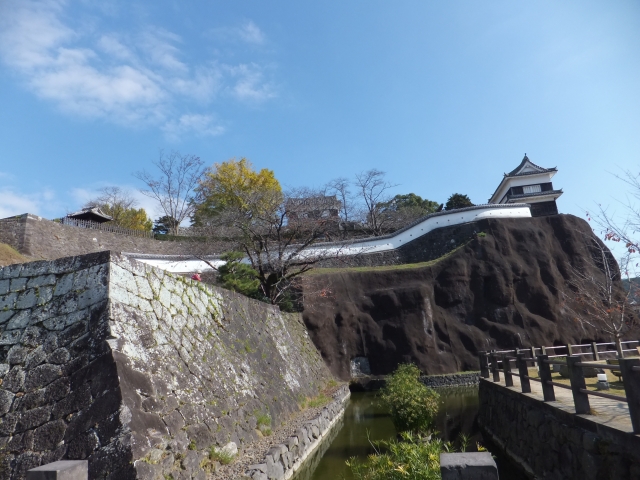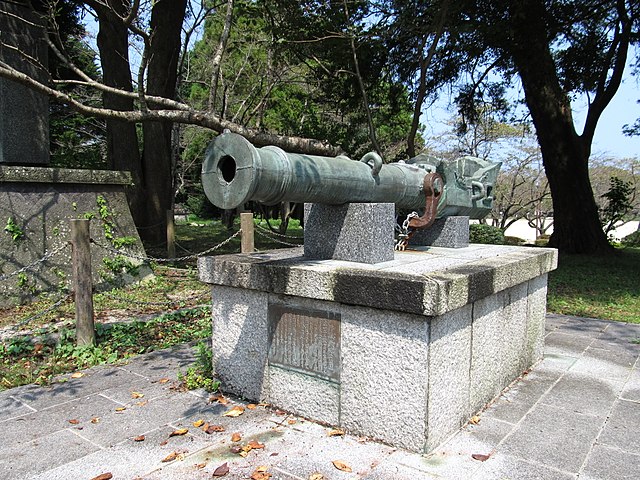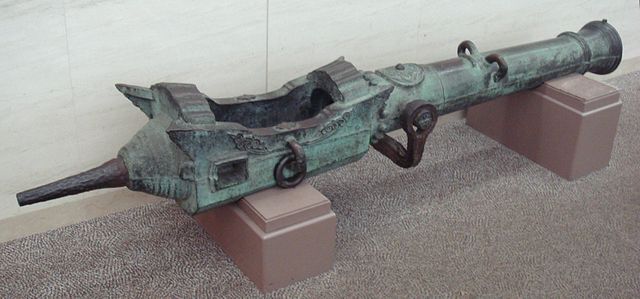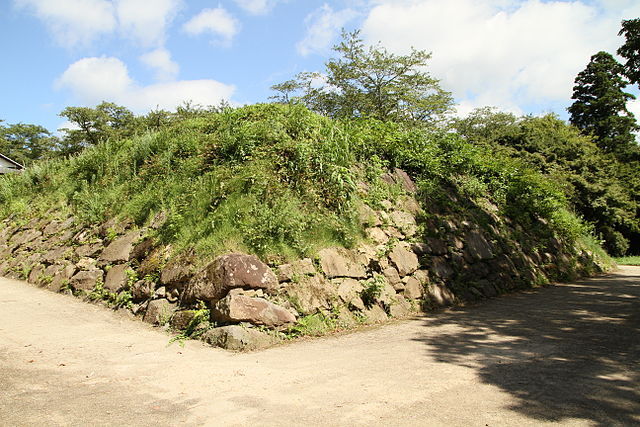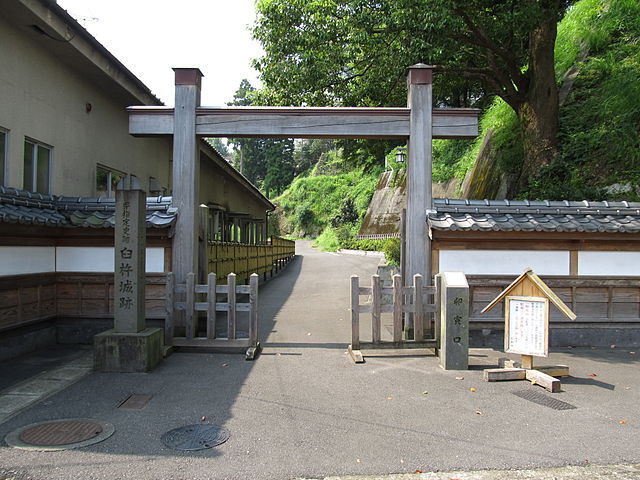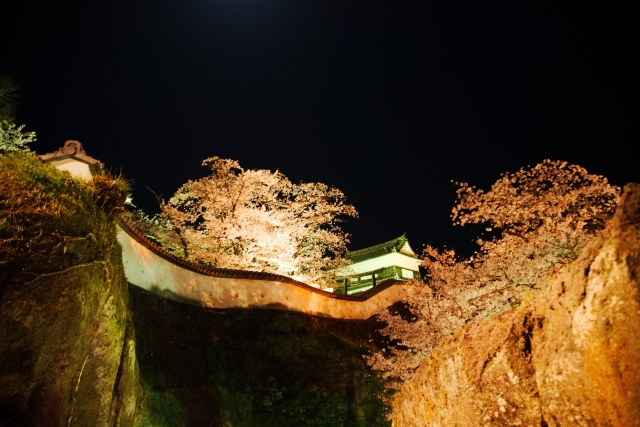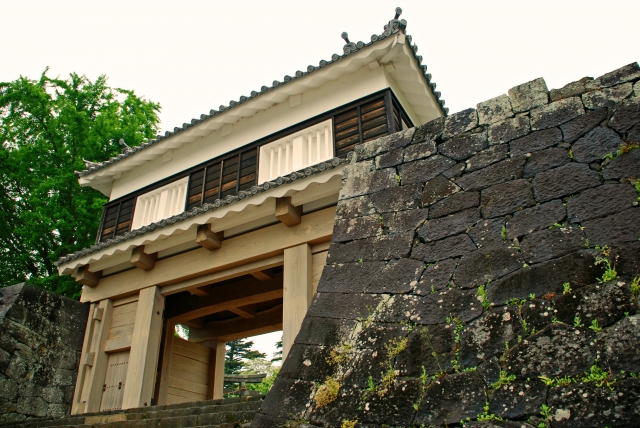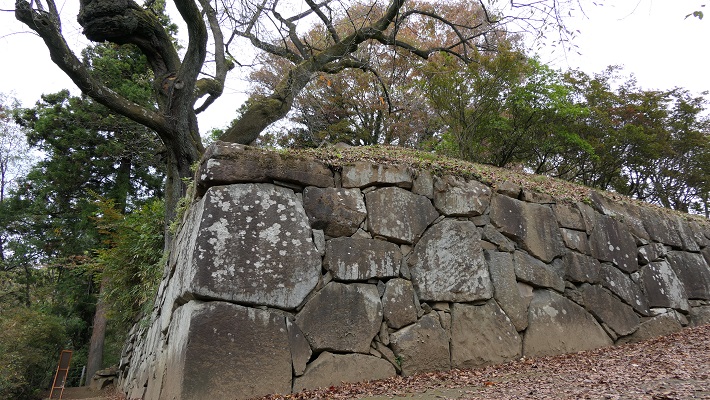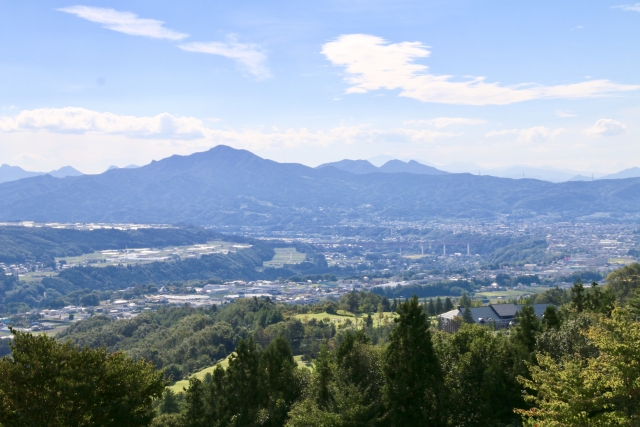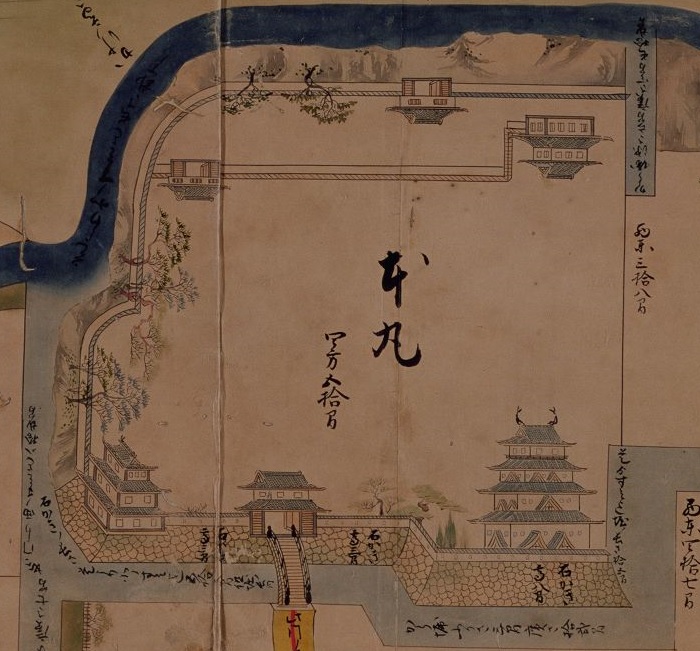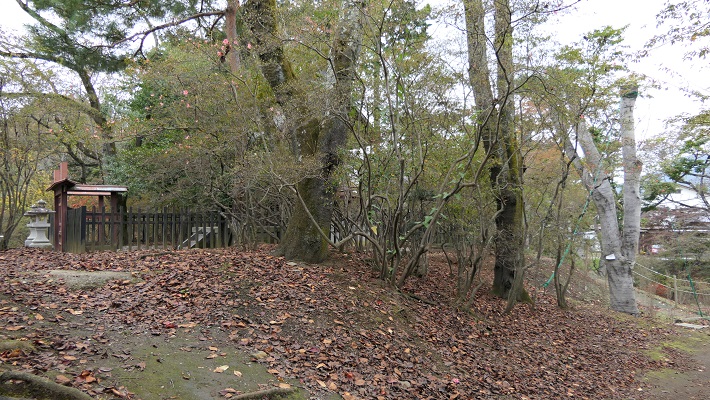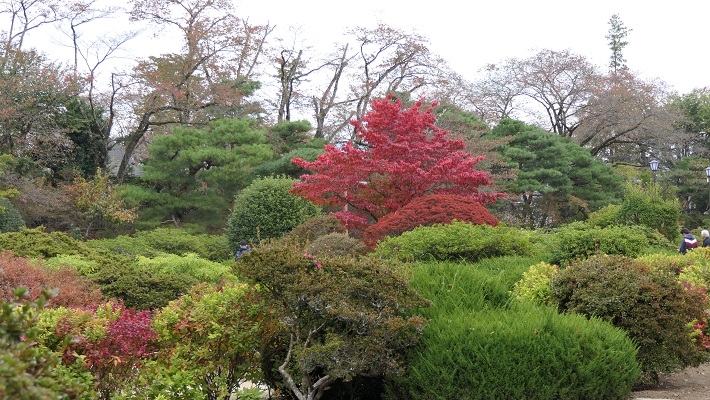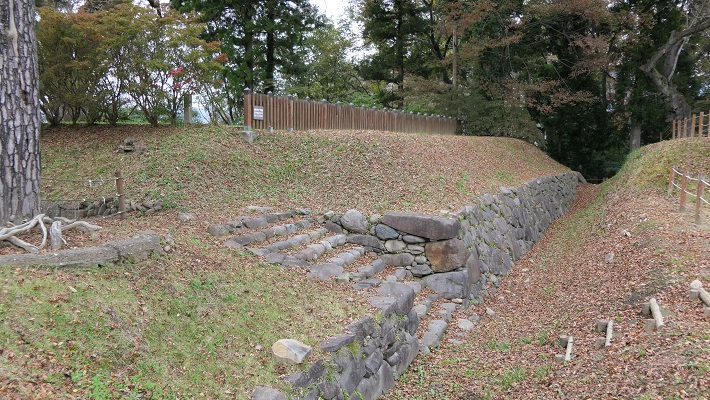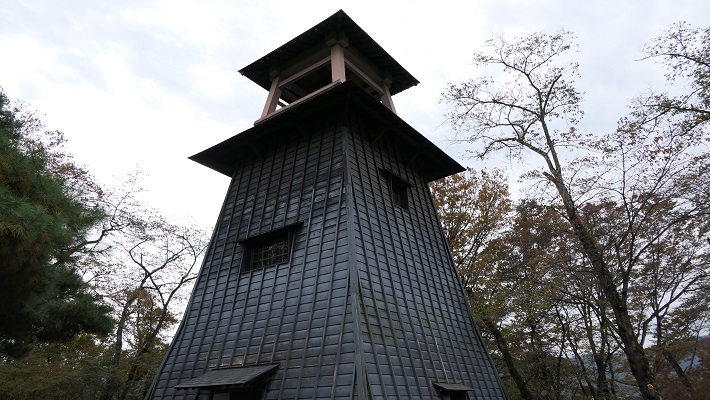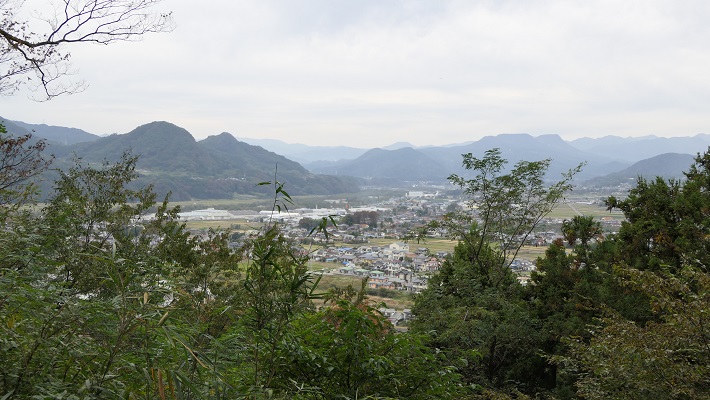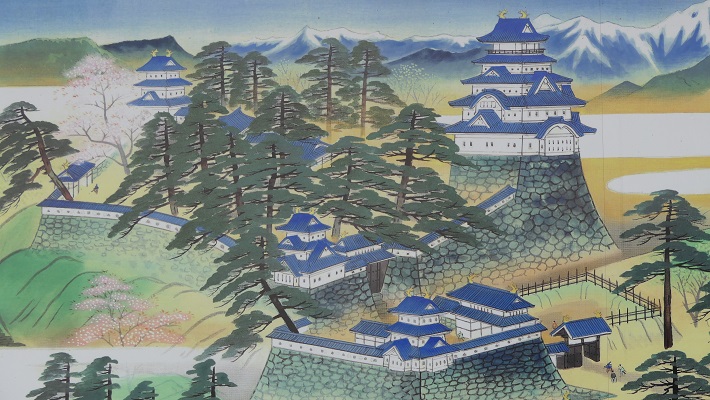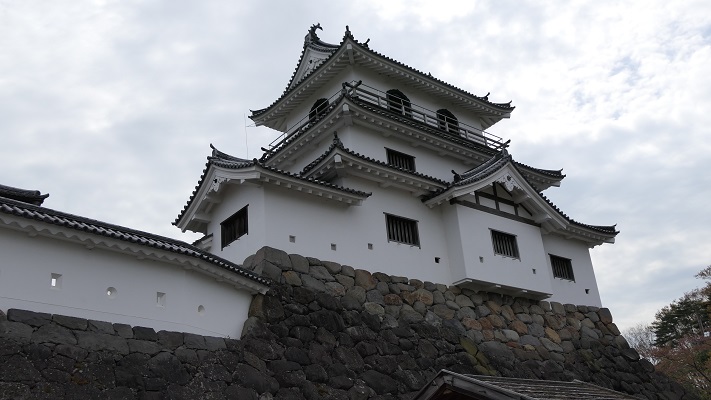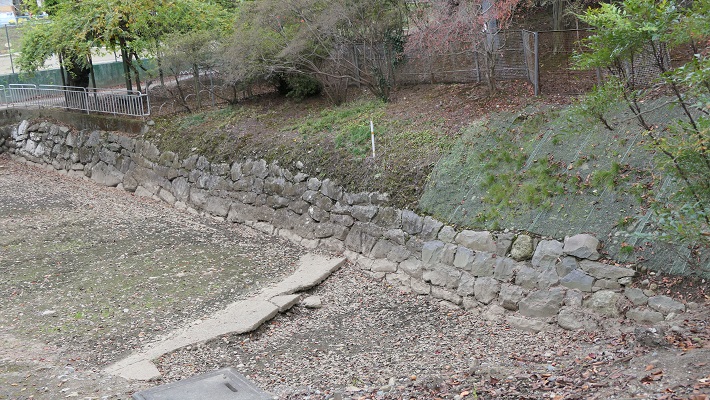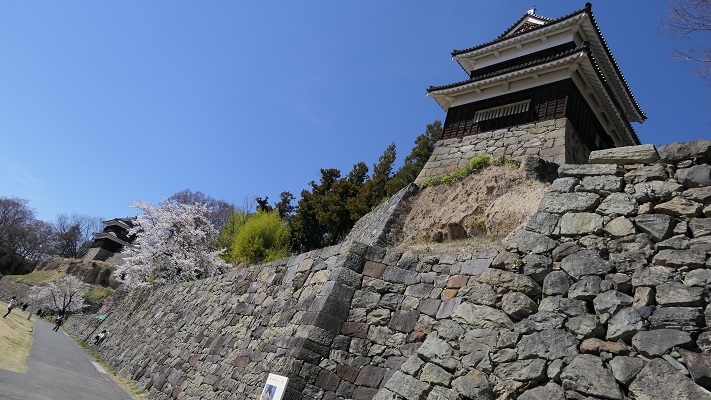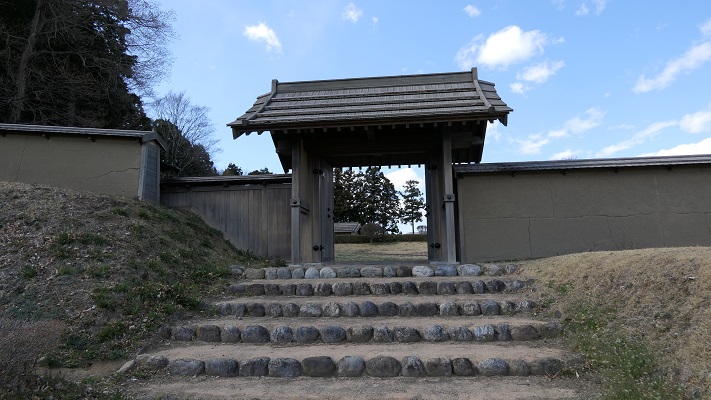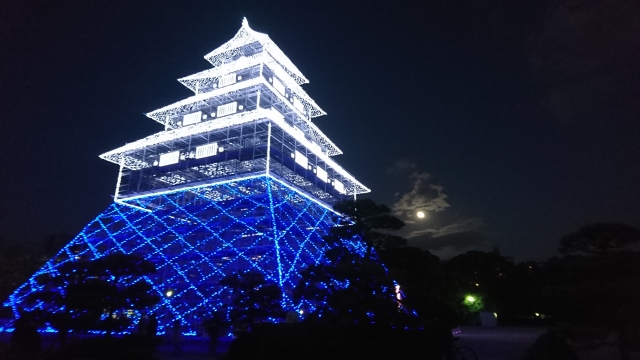武士たちはこの「天空の城」を最後まで守り抜きました。
Warriors protected this “Sky” Castle till the end.

立地と歴史~Location and History
岡城には有名な古の武将、源義経にまつわる伝説があるのですが、定かではありません。南北朝時代になって、大友氏配下の志賀氏が最初にこの城を築いたと言われています。この城は、現在の大分県の「天神山」という岩山にあり、大野川と稲葉川という二つの川に挟まれていて、それらがこの城を難攻不落たらしめていました。事実、戦国時代後半に島津氏の攻撃を三度に渡り撃退しています。
Oka Castle has a legend about its origin of a famous ancient general, Yoshitsune Minamoto. However it is uncertain. It is said that in the period of Northern and Southern Courts, the Shiga clan under Otomo clan first built the castle. The castle was located on a rocky mountain called “Tenjin-Yama” in now Oita Prefcture, sandwiched by two rivers, “Ono-Gawa” and “Inaba-Gawa” making it impregnable. Actually, the castle repelled the Simadu clan’s attacks three times in the late Warring States Period.
城周辺の起伏地図~The relief map around the castle
豊臣氏の支配下、中川秀茂が城主として派遣されました。城の範囲は山の全域に広がりました。彼はまた、天守、高石垣、そして大手門、近戸門、下原門という三つの門を作りました。そして城の西の方に、「竹田」という新しい城下町も作りました。
Under the Toyotomi clan’s governance, Hideshige Nakagawa was sent as the lord of the castle. The range of the castle was spread to the entire mountain. He also built the Tenshu keep, high stone walls and three entrance gates – Ote-Mon, Chikado-Mon, and Shimobaru-Mon”. He created the new castle town called “Taketa” in the west.

彼の子孫は、城と城下町を江戸時代を通して統治しました。そして戦いの準備のため、きびしい決まりを維持したのです。例えば、彼らは山の上の不便な住居に暮らし続けました。訪問者は門で厳密にチェックされ、入城を許されても藩士が常に付いて回りました。城内の畳は、籠城のときの食料とするため甘芋蔓によって作られました。岡城は山の上にあるため、頻繁な修繕を必要とします。更には火事や地震にも度々襲われました。その結果年貢は重くなり、百姓は「四原一揆」として知られる一揆を起こしたりしました。
His descendants continued to govern the castle and the town all through the Edo Period. They kept their strict rules to prepare for a battle. For example, they were living in inconvenient residences on the mountain. Visitors were checked very strictly at the gates, even if permitted to enter, clansmen always attended to them. Tatami mats were made from sweet-potato vines for food in case of a siege. Because Oka Castle was on the mountain it needed frequent maintenance. It often suffered from disasters like fires and earthquakes. Because of this taxes were high. The farmers rioted in an incident known as “Yoharu Ikki”
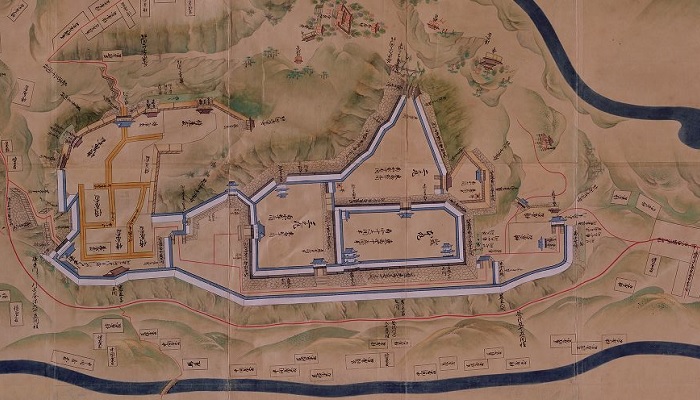
特徴~Features
現在、岡城の城跡には建物は残されていません。でも独特の雰囲気が漂っています。通常は遺跡の正門である「大手門」から入ります。石造りの曲がりくねった坂道が門の跡に通じています。
Presently, the ruins of Oka Castle have no buildings, but have a unique atmosphere. Visitors usually enter from the ruins of the main gate “Otemon”. A zigzagged slope made of stones leads you to the gate ruins.
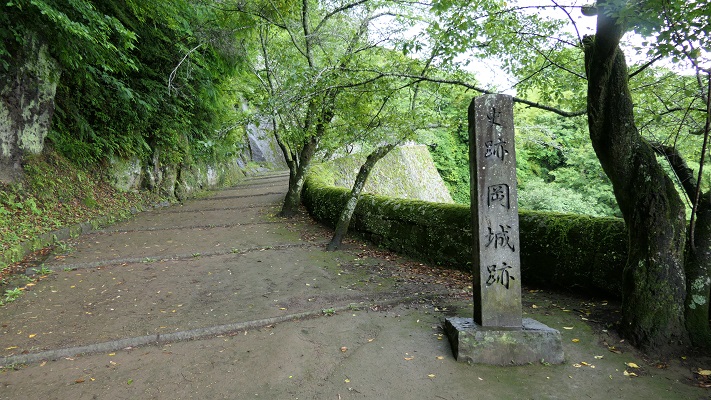
道の石造りの手すりは丸みを帯びていて「かまぼこ石」と呼ばれています。それはまた苔むしていて、とても美しく見えます。
Its stone fences are round-shaped and called semicylindrical stone “Kamaboko-Ishi”. They are also mossy and look very beautiful.
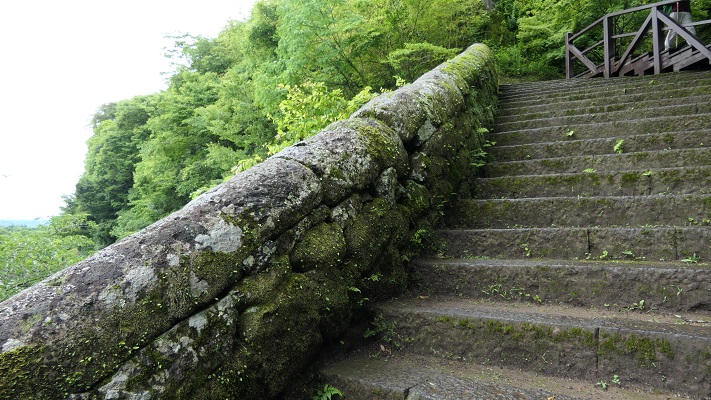
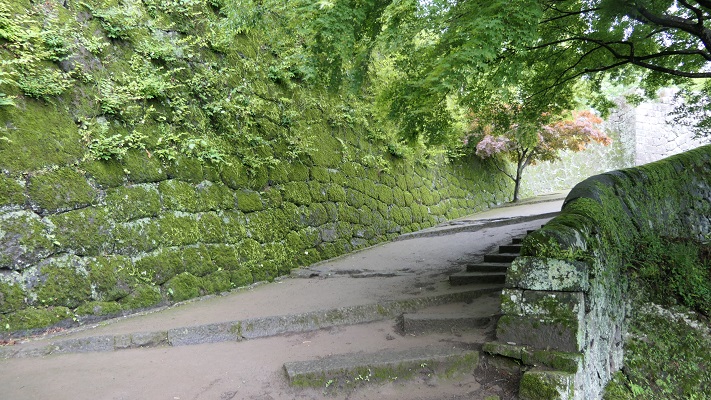
門を過ぎると、「西の丸」と呼ばれた比較的広い場所があり、江戸時代には藩主の住む御殿がここにありました。
Passing through the gate, there is a relatively wide place called “Nishi-no-Maru” where the main hall for the lord was in the late Edo Period.
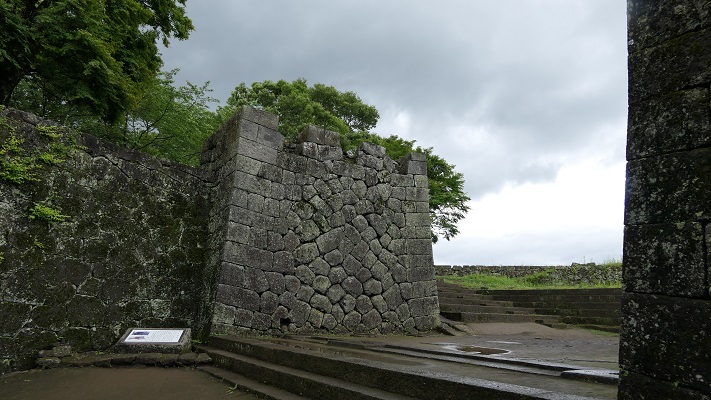
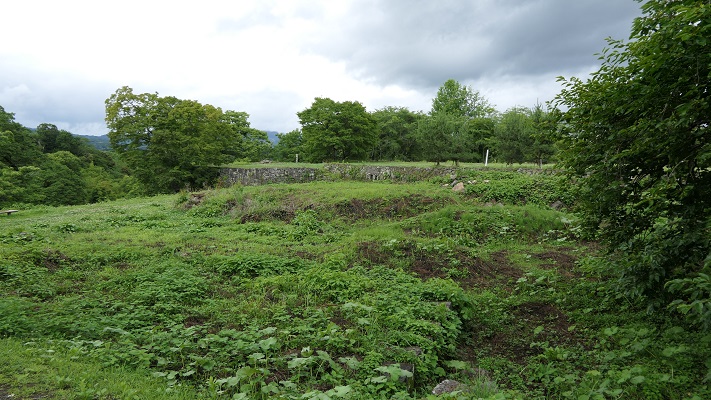
城跡の真ん中辺り、山が狭くなっている所が城の中心部分で高石垣に囲まれています。特に「三の丸」にある高石垣が観光客の間で有名です。でも、写真を撮るときは足元に十分気を付けてください。
In the center, you can see the main part of the ruins on a narrow hill surrounded by high stone walls. In particular, the ones in “San-no-Maru” are very popular among tourists. However, watch your step when taking pictures.
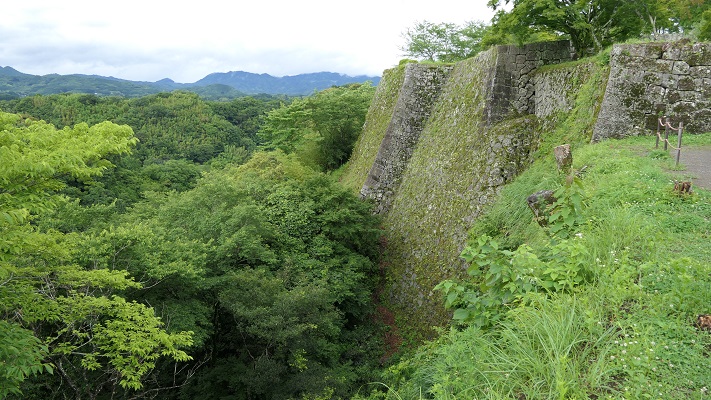
阿蘇山といった周りの景色の眺めも素晴らしいです。
You can also enjoy the surrounding landscape such as Mt.Aso.
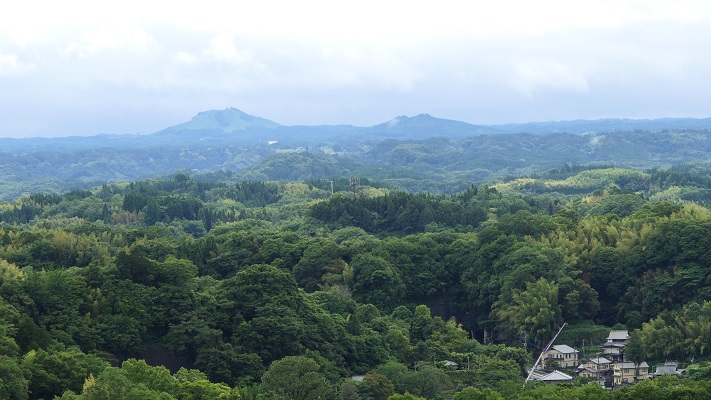
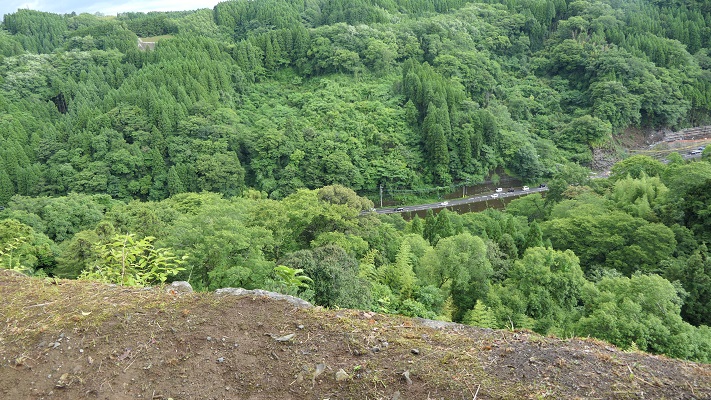
城跡の裏側には「下原門」があります。この門は、志賀氏がいた時代には正面口として使われていました。
The back of the ruins are the gate “Shimobaru-Mon”. The gate was used as the main entrance in the Shiga clan’s Era.

反対側に戻ったら、通用門として使われた「近戸門」から外に出てみてはいかがでしょう。通用門といっても石組は精巧に作られています。「七曲り」と呼ばれた外に続くつづら折りは、石垣と石畳によりすごく見栄えがします。
Going back to the opposite, why not come out of the ruins of the gate “Chikado-Mon” which was used for the side gate, but its stone base has been elaborated. The outside winding road called “Nana-Magari” is good looking with stone walls and stone pavement.
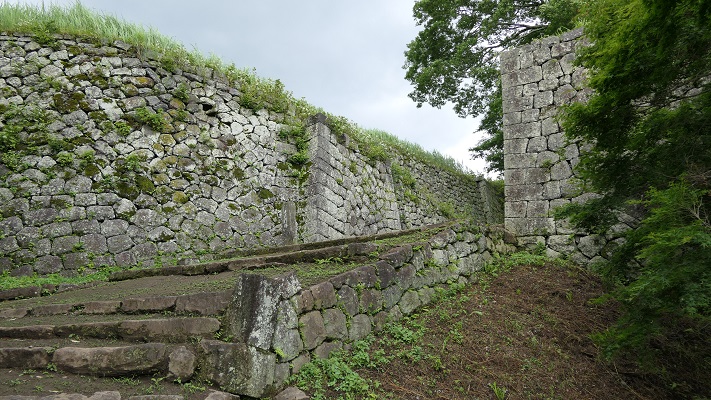

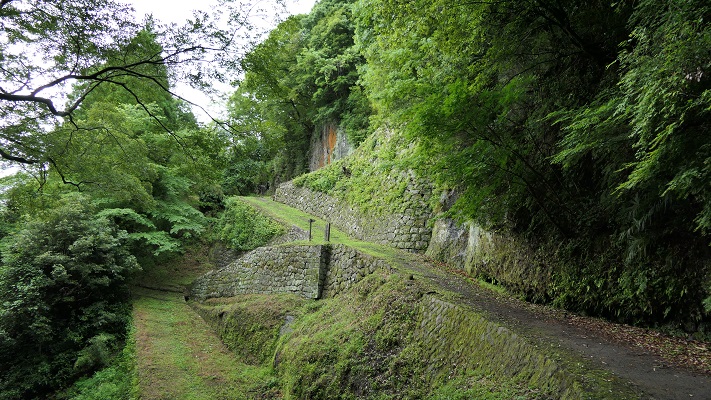
Later Life
明治維新後、城を維持する必要はなくなりました。武士だった人たちは皆この不便な住居から町の方に移っていきました。城は荒廃しました。全ての建物は二束三文で売られていきました。若き作曲家、滝廉太郎はこの城跡を見て、有名な「荒城の月」を作りました。二の丸の地に彼の銅像があります。
After the Meiji Restoration, there was no need for keeping the castle. Former warriors all moved to town from this inconvenient residence. The castle ran to ruin. All the buildings in it were sold at a low price. A young composer, Rentaro Taki created a famous song called “Moon over the Ruined Castle” “Kojo-no-Tsuki” after looking at the ruins. You can see his statue at Ni-no-Maru.
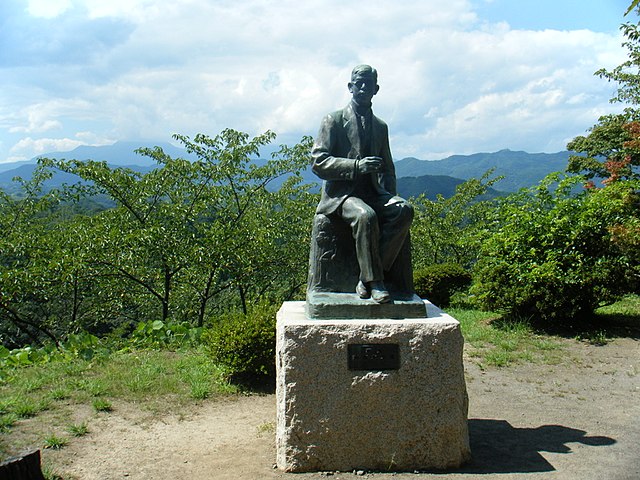
地元の人たちは、1886年に最初に記念碑をこの地に建てました。1936年には、城跡は国の史跡に指定されます。現在、ここは桜の名所としても有名です。 Local people built the first monument in the ruins in 1886. They were designated as a National Historic Site in 1936. Now, they are known for cherry blossoms as well.

私の感想~My Impression
300年近くもの間、平和な江戸時代の間でさえ武士たちが岡城に住み続けたことにとても驚きました。彼らは長い間いつ起こるかわからない戦争のために備えていたのです。城を離れなければいけなくなったとき、武士たちがどう思ったのか知りたいところです。
I was surprised to know that warriors had been living in Oka Castle for nearly 300 years, even in the peaceful Edo Period. They were prepared for an unexpected war for a long time. I wish I was able to know how they felt when they had to leave the castle.
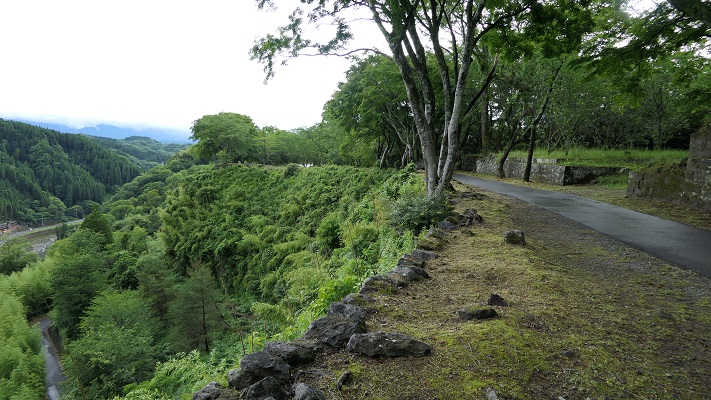
ここに行くには~How to get There
JR豊後竹田駅から歩いて30分近くかかります。
大分空港から臼杵駅まで:
大分駅行き空港アクセスバス(エアライナー)に乗り、大分駅でJR豊肥本線に乗り換えてください。
車で行く場合:大分自動車道大分光吉ICから約60分、または九州自動車道熊本ICから約90分。城跡には大きな駐車場があります。
It takes nearly 30 minutes From JR Bungo-Taketa station to get there on foot.
From Oita Airport to Bungo-Taketa st.:
Take the Airpor Eepress Airliner bus to Oita station, and transfer at the station for JR Houhi line.
If you want to go there by car: It takes about 60 minutes from the Oita-Mitsuyoshi IC on Oita Expressway, or about 90minutes from the Kumamoto IC on Kyushu Expressway. The ruins offers a large parking lot.
リンク、参考情報~Links and References
・竹田市岡城跡(Only Japanese)
・「豊後岡城物語 義経、秀吉から「荒城の月」まで」吉田健二著(Japanese Book)
・「よみがえる日本の城20」学習研究社(Japanese Magazine)
・「歴史群像2015年12月号/戦国の城・豊前岡城」学研プラス(Japanese Magazine)

